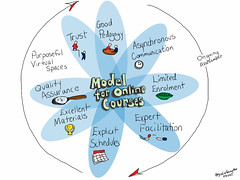As I venture through my online teaching and course development I have been drawn to the question, what does an effective online teacher look like? If I am to develop a good online course then I will need to know what aspect I need to include in the course that would facilitate good online teaching practices.
Tallent-Runnels, Cooper, Lan, Thomas, and Busby (2005), wrote an article called How to teach online: What the research says and they highlight seven basic concepts to successful online teaching:
1. Provide helpful resources on the course site: their summary indicated that “guiding questions helped students focus and develop their projects” (pg. 21)
2. Let students have control over the pace that they work through the course: they did indicate that their findings were mixed and that the more successful students finished the work sooner than the less successful students.
3. Have lots of discussions: their research included suggestions such as “keeping the interactions high in discussions, modeling and reinforcing effective communication, identifying potential problems, and designing a plan for dealing with them” (pg. 23)
4. Provide timely feedback to students about their performance: “Instructors must learn to teach almost daily in smaller time blocks, because students want and need individual feedback in a timely fashion” (pg 23)
5. Provide technical support for students
6. Online study aids and step-by-step presentation may not make much difference in achievement: They quoted a study done by Mayer and Chandler in 2001, where they compared the “benefits of adding simple user interaction to a multimedia presentation” (pg. 23) and found “little difference between retention rates” (pg. 23)
7. Evaluation can be enhanced in online courses: They suggest that “the formats of assessment that they have been using in traditional instruction, such as term papers and multiple choice questions, may not provide valid and comprehensive information on students’ learning” (pg. 23). “Questionnaires administered in online courses and correspondences between instructors and students provide instructors with enriched information to evaluate not only what students learn but how they learn” (pg 25)
Lewis and Abdul-Hamid (2006) wrote an article called Implementing effective online teaching practices: Voices of exemplary faculty and they site four broad categories for effective online teaching practices:
1. Fostering Interaction: Their study emphasized the need for “vibrant interaction among students and between the instructor and the students” (pg. 87). Among their findings was that of beginning each course with an introduction through an introductory conference and/or through an introductory discussion board where they have to introduce themselves and respond to others. The continuous interaction should be kept up through conferences, chat rooms, and e-mail. One of their faculty participants gave a caution about discussion boards, “they have to be interesting issues. They can’t be no-brainers that 30 people have the same answer to and post 30 similar answers. They have to be interesting enough that people can come at the questions in a little different way and have a little different interpretation” (pg. 88). They also suggested a discussion board just for student interaction so that the students have the opportunity for social interaction where the teacher presence was absent. They called these discussion boards “The Café” or “Harmony House” (pg. 88). In addition to creating interaction through discussion boards their participants commented on the need for group work among students through group projects or study groups.
Cole and Kritzer (2009) also commented on “Getting to Know You” discussion boards and stated that “some students feel more comfortable participating in electronic discussion boards because they may feel more anonymous in their postings, they can post their thoughts at a pace that is comfortable to them, and they do not have to compete to be heard” (pg 37).
Cole and Kritzer (2009) also commented on “Getting to Know You” discussion boards and stated that “some students feel more comfortable participating in electronic discussion boards because they may feel more anonymous in their postings, they can post their thoughts at a pace that is comfortable to them, and they do not have to compete to be heard” (pg 37).
2. Providing Feedback: “Participants resoundingly reported that providing quick, quality, and in-depth comments is critical in maintaining a presence in the online classroom, they also acknowledged that providing such feedback to students can be a lengthy and challenging process. Most faculty reported that they are online very frequently in order to provide a high level of attention to their online students” (pg 91). They gave the example of cutting and pasting comments to students in a FAQ section for other students to access.
3. Facilitating Learning: Of importance was to reinforce the course goals through a syllabus and then periodically throughout each unit. Suggestions for this were to have a quiz based on the syllabus to reinforce the course goals (pg. 93). Other faculty in the study used personal experiences and current events to supplement the course material in order to make the content relevant to students (pg. 93). Another strategy was to use video clips and digital resources that offer a different approach to understanding the material (pg. 93).
4. Maintaining Enthusiasm and Organization: “Given the reality that most of the communication in online courses must be written and clearly presented to students without the assistance of bodily cues or facial expressions, many participants stressed the need for faculty to be organized and energetic and to have a visible persona in the classroom” (pg. 94) Faculty from this study commented on how they sent out weekly e-mail greetings that remind them of the current topics.
Cole and Kritzer (2009) in their article Strategies for success: Teaching an online course also sited discussion boards as useful in maintaining an instructor presence and facilitating community in addition to weekly video messages (pg. 40).
Cole and Kritzer (2009) in their article Strategies for success: Teaching an online course also sited discussion boards as useful in maintaining an instructor presence and facilitating community in addition to weekly video messages (pg. 40).
Cole and Kritzer (2006) expressed the need to create each unit as a module where all of their objectives, readings, presentations, questions, and activity were presented in one complete block. They commented on the advantages of organizing the course into modules: “Everything is together and ready for the students to do on their own time…Once the faculty member has the modules set up, the remainder of instructional time can be spent addressing student questions, providing feedback on the interactive activities and projects, and problem solving any issues that may arise” (pg. 39).
As I reflect on these practices and suggestions I am encouraged that I do implement a lot of these strategies but I also struggle with the schools that just want the old correspondence courses where there is no interaction and community and the student learns in isolation. Is there still a place for correspondence courses or should the schools that are looking for corespondence courses have to 'get on board' with the best practices as listed above and encourage more student interaction and discussion?







